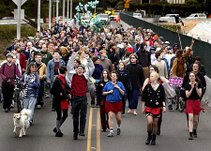[olympiaworkers] 1935: Battle of Ballantyne Pier
http://libcom.org/history/1935-battle-ballantyne-pier
Mounties clash with dockers
A short history and background of the 1935 dockers' strike and subsequent
bloody confrontation with police in Vancouver that became known as the
Battle of Ballantyne Pier.
The story of the Battle of Ballantyne Pier can be traced back to 1912 when
the International Longshoremen's Association (ILA), began organising
amongst waterfront workers in Canada, and alongside the Lumber Handlers'
Union in Vancouver. Going head to head with the employers association, the
Shipping Federation, several strikes resulting in wage increases were won
by workers in the coming years. Victories on the waterfront increased over
the next decade, and by 1923 the Shipping Federation became determined to
break the power of the ILA.
A strike, possibly provoked by the employers' association, broke out in
October 1923 which saw 1400 men joining picket lines at the Vancouver
waterfront. However, provisions had been made by the Shipping Federation.
The dockers were immediately met by 350 men armed with shotguns who had
been housed on a nearby ship. This premeditated intimidation of the
strikers, coupled with the fact that ships were still being loaded and
unloaded by numerous scabs who had been drafted in, forced the strike to
collapse two months later.
The 1923 strike destroyed the ILA, and it was soon replaced a new
organisation, the Vancouver and District Waterfront Workers' Association
(VDWWA). Set up originally by the bosses as a company union, the VDWWA
soon began to take a confrontational stance towards the Shipping
Federation. By 1935, nearly every port in British Columbia had been
organised by the VDWWA. Following the pretext to the destruction of the
ILA, the Shipping Federation provoked another major strike in the spring
of 1935, locking out 50 dockers at the port at Powell River.
The strike soon snowballed to bring other dockers across the region into
the fold. Following a refusal to unload ships coming from Powell River,
900 workers were met with a lockout in Vancouver. Dockers across the
border in Seattle also refused to unload ships coming from Vancouver and
Powell River that were manned by scabs.
On June 18, several weeks after the original lockout, between 900-1100
dockers and their supporters marched through Vancouver towards Ballantyne
Pier where scabs were unloading ships. The strikers were met at the pier
by several hundred armed policeman. Attempting to force their way through,
the dockers soon found themselves under attack from the police lines. Many
marchers were clubbed as they tried to run to safety, while many others
tried hopelessly to fight back, using whatever weapons they could find.
Aided by Mounties who had been posted nearby, the police continued to
viciously attack the strikers. The VDWWA union hall was attacked, with
tear gas being used against members of the women's auxiliary who had set
up a first aid station inside. The battle continued for three hours, and
ended with several hospitalisations, including that of a fleeing striker
who had been shot in the back of his legs.
Dragging on until December, the strike lost much of its militant character
after the fighting at Ballantyne Pier. The struggle to form a union
completely independent of the Shipping Federation continued for another
two years, when, in 1937, the International Longshore and Warehouse Union
(ILWU) was born.
The strike of 1935 failed. It did, however, lay the path for the future
founding of a union for the dockers of British Colombia which was
completely independent of the employers' association. The ILWU
participated in numerous disputes in the following years, and in the 1940s
was integral in winning many strikes that lead to better pay and
conditions for waterfront workers.
Alex Aspden


No comments:
Post a Comment